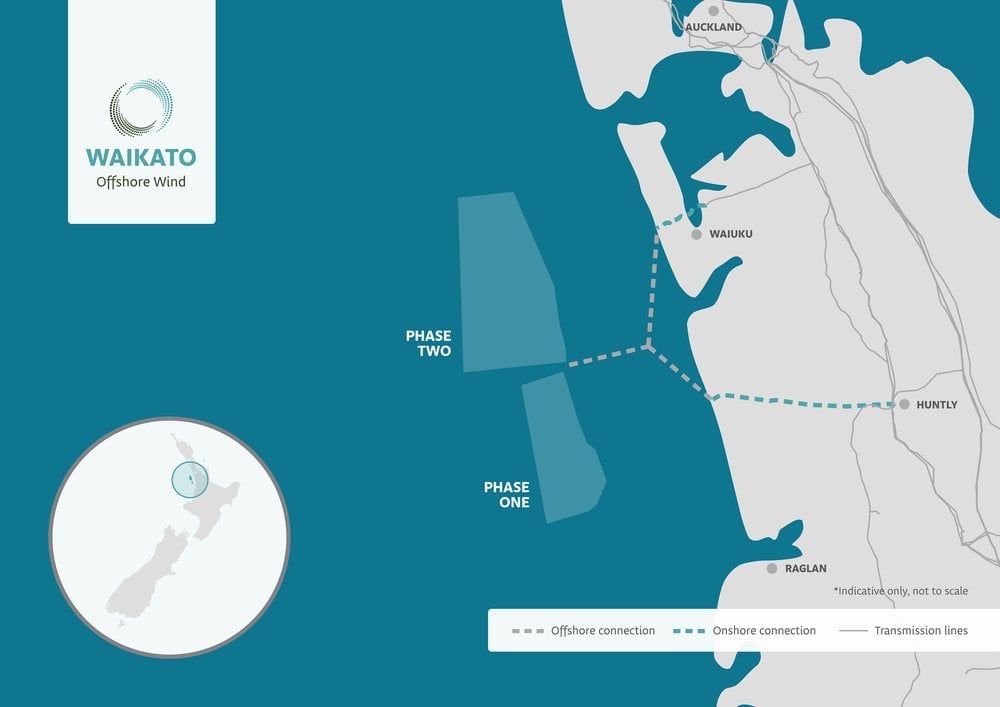
A wind farm off the coast of Auckland or Waikato would fit well with the existing power grid and demonstrates the value of spreading offshore development around the country, developer BlueFloat Energy says.
In contrast to Taranaki, Waikato wind patterns are “very negatively” correlated with those of the country’s onshore central North Island wind farms, country manager Nathan Turner says.
They are also highly skewed toward winter production – New Zealand’s peak demand months – with July, August and September typically 20 per cent higher than average, he told guests at an industry function in Auckland last night.
Such a site also benefits from being close to existing and growing load growth.
“Our Waikato project would potentially connect into the grid right around Huntly or Glenbrook – obviously one of the strongest parts of the grid today – and quite close to the large electricity demand centre that is Auckland.”
Ambitions
BlueFloat and partner Elemental Group are among a handful of global wind players keen to tap this country’s long-recognised wind resource for offshore development.
Most of the interest has been in a “goldilocks” area of relatively shallow water and high wind speeds off the southern Taranaki coast, but Waikato, Southland and Wellington projects are also being investigated.
One of the challenges of developing offshore projects – typically 1GW in scale – is how to integrate them into New Zealand’s relatively small market and relatively stringy national grid.
While the Taranaki wind resource is excellent, an analysis by PwC earlier this year suggested that while one project there could be relatively easily absorbed, two could require a transmission upgrade of about $1 billion.
Wind developers eyeing the Taranaki coast are also competing with Trans-Tasman Resources which wants to mine a multi-decade vanadium ironsands resource.
Best projects
Turner was speaking in Auckland last night with BlueFloat’s chief commercial officer Pierre-Antoine Tetard. About 90 guests attended the event hosted by Simpson Grierson and the BusinessNZ Energy Council.
BlueFloat was formed in 2020. It now has about 150 people working on 33 projects, with a combined capacity of 34 GW, in 10 countries, including Australia, the Philippines and Taiwan.
“We have a long-term perspective in mind,” Tetard told the gathering. “We are convinced that what matters is to develop the best possible project, not only the cheapest possible project.”
Turner said that, internationally, grid connection is proving a problem for many developments. Locating New Zealand projects close to loads will be really important.
Spreading projects geographically will also be important in helping provide a more base-load profile of wind production, he says.
Regions
While Taranaki is not a big demand centre now, he says it has a lot of industry reliant on gas that will need to transition to greener fuels in the future.
Southland, where there are ambitions to build data centres, a hydrogen industry and replace coal in process heat, is another region of strong potential load growth.
In his presentation, Turner showed average wind speeds for Southland at about 10.8 metres a second, South Taranaki at 10.1 m/s and Waikato at about 8.4 m/s. The firm’s own Waikato project has an average wind speed of 8.8 m/s.
While that may look weak, Turner says Waikato’s wind speeds are still attractive relative to other countries where projects are being advanced.
“Actually, it is still quite good and compares very similarly to the types of capacity factors that are being seen in places like Gippsland that have attracted so much development interest from international investors.”
Earlier this year, Australia’s federal government awarded 12 feasibility licences for up to 25 GW of development off Victoria’s Gippsland coast. BlueFloat was among the successful bidders.
Gavin Evans – Thu, 11 Jul 2024
